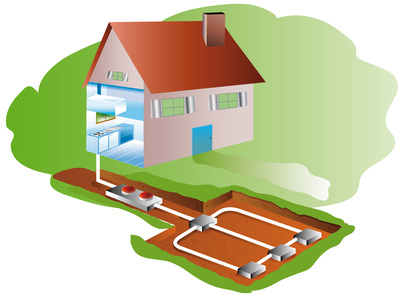Geothermal Energy Illustrated
A deep well is drilled to access steam and hot water deep before the surface of the Earth and the extremely hot water is pumped up and the steam from it powers a turbine generator which creates electricity. The spent water is then cooled and injected back into the hot rock layer it came from with use of a second well.
Locating areas useful for harvesting geothermal energy usually meant finding the major fault lines where volcanoes and earthquakes are common. The fractured rock plates along the fault shift and tilt, and areas fill with super hot water.

Along fault lines, the thermal energy is much closer to the surface than found in other geographical areas. Hydrothermal regions are found in topography where porous rock layers trap water and heat it.
The Ring of Fire is an area that circles the boundary of the Pacific Ocean. This is a highly desirable region for geothermal power production and is the area where the majority of the world's earthquakes and volcanoes are found.
In the U.S. most geothermal potential is found in the western states, in Alaska and in Hawaii. California leads in the most electricity generated with geothermal energy. In the north part of California, The Geysers is the largest known dry steam geothermal field and plants in that area have been producing power since 1960.
Four Types
There are four types of geothermal resources: hydrothermal, geo-pressues, hot dry rock and magma. At temperatures of more than 250 degrees Fahrenheit, geothermal resources can used to produce electricity.
When the temperature is great than 105 degree Fahrenheit, a geothermal field is useful for use in providing direct heat to greenhouses and creates comfortable hot springs in some resort areas.
In the United States, the top three states are California, Nevada and Utah. Other states where geothermal reservoirs are found are Alaska, Arizona, Colorado, Idaho, Hawaii, New Mexico and Oregon. Most diagrams of thermal energy resource areas divide the fields in two colors - one for good-excellent and a second color for moderate potential.
Geothermal energy use, managed properly, is a resource that is not exhaustible as it is a renewable resource. Part of a plan is the low cost to operate such a power plant and there is a definite market for the electricity produced.
Though there are various diagrams for thermal energy production, all of them are simply method of capturing and using natural heat sources located deep in the earth and then returning the waste back to the earth for re-heating. In the eastern Sierra Nevada Mountains three huge binary units release no damaging emissions into the air or ground water and generate 28 megawatts of electricity.
Using Power Produced
Plants can generate electricity and route it to a central power station for a single town or area or can distribute power by routine the electricity created to a huge power grid. The energy can be used for agriculture, aquaculture, and for heating processes directly to warm greenhouses, the floors in your home or even to heat a swimming pool.
There are 270 cities in the western U.S. states that are located close to geothermal reservoirs and can use those reservoirs for heating in the district. In total there are eighteen districts in the U.S. using geothermal systems.
While producing energy offers great promise the heat of the water/steam that comes from deep wells can be used directly by routing that heated product through pipes. When sent instead into turbines/generators, electricity is the end product and that electrical power can be distributed to run systems in many homes.
There are also diagrams for geothermal energy that are designed for agricultural purposes. In these instances, the heat captured can warm the soil to provide a longer or better growing season and can stabilize water temperatures for fish farming and alligator farming. The same heat energy has industrial uses as well as being useful for residences and farming.
In a diagram for geothermal energy for a single home, heat can be collected from underground water reservoirs and piped directly under the floors of a structure to provide heat in a cost effective way. This is popular heat pump technology and in reverse warm air can be moved from the home into the ground for cooling.
Heat Pump
Heat pumps are suitable for homes and industries. They are environmentally friendly and can be installed many different ways which makes them suitable for many buildings and locations. This is a proven technology with a 15-25 year life span and is a high efficiency heating and cooling system.
